015. Mickalene Thomas
Rhinestones, Resistance, and Representation: The World Through The Eyes of Mickalene Thomas
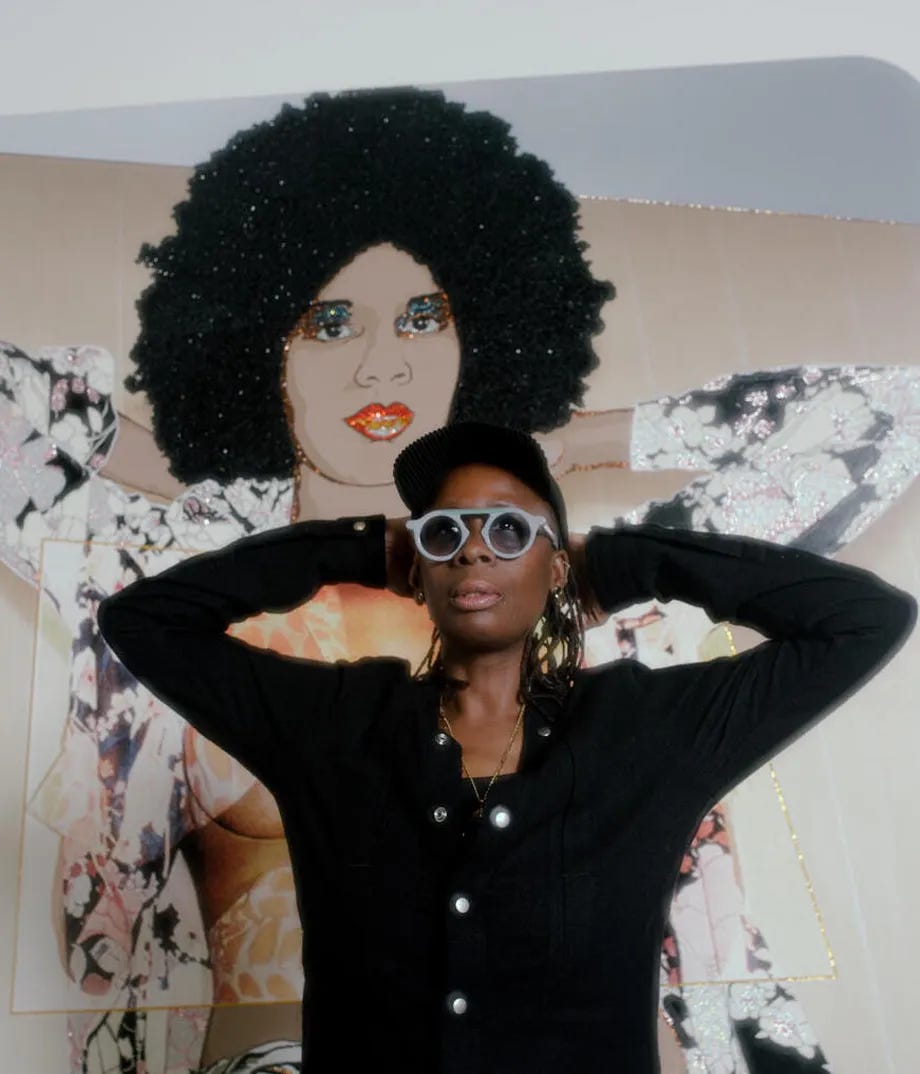
Introduction
Mickalene Thomas is a revolutionary figure in contemporary American art, renowned for her richly textured paintings, photography, and mixed-media work that reframe notions of beauty, identity, and representation. Known for her bold depictions of black women and the LGBTQIA2S+ community, Thomas blends personal history with cultural critique. Her work challenges historical exclusions in Western art and asserts black, queer presence unapologetically within museum walls. Over the past two decades, she has reshaped contemporary portraiture, crafting vibrant images that honor individuality, sensuality, and power.
“I like to put Black women in the same positions as the subjects in Old Master paintings, because it’s about having that freedom to just be in the moment, to recline without doing work. Can’t we just recline? Can’t we have that moment of being looked at without having to have all of this baggage? Can’t we luxuriate?”
— Mickalene Thomas in an interview with Whoopi Goldberg for Interview Magazine
Thomas’s career embodies more than artistic innovation; it also signals a cultural shift. Her dazzling visual language—rich with rhinestones, vibrant colors, and references to art history—reclaims spaces that have historically marginalized black women. Through her multidimensional practice, Mickalene has become a beacon of authenticity, using her platform to elevate stories often overlooked in dominant narratives. She navigates the art world with a dual mission: honoring her personal lineage while broadening conversations about identity, feminism, and queer visibility. She and department chair of painting at Pratt Institute, Jane South, are co-founders of Pratt Forward, a mentorship program that provides practical business strategies for artists’ careers. She is also co-founder, along with her former partner, Racquel, of Deux Femme Noire, a platform that helps artists of color and women queer artists to pursue their creative endeavors.
“I think cofounding both will create very intelligent, strong artists who have a great sense of both the creative and business sides of their practice. One of my students called me up and said, “You know, you doing that class of artists in the marketplace was one of the best things we’ve had at Yale. And I’m so happy that you were there.” That just shows that what we’re doing works, because the business of art is not taught in schools. It’s integral to what they’re doing. It really does make or break the success of most artists if they don’t have that support system or knowledge. It’s really important for me to create a foundation for these artists so they know that they’re not alone in their endeavors. And it’s a huge impact for artists of color to know their worth. That’s what I want to be part of my legacy.”
— Mickalene Thomas in an interview with Bryna Jean-Marie for Oprah Daily

At the heart of Thomas’s work is a profound respect for self-definition. Whether through her portraits, installations, or video work, Mickalene asks: who has the right to be seen, and on whose terms? Her art is as much about empowerment as it is about aesthetics, sparking dialogues that transcend gallery walls and ripple outward into broader cultural discourses.
Both as a member of, and inspired by, the Post-Black Art movement, Thomas' work redefines perceptions of race, gender, and sexuality. Mickalene blurs the distinction between object and subject, concrete and abstract, real and imaginary. Her subjects often look directly at the viewer, challenging the dominance of the male gaze in art. This assertive portrayal indicates that the models are at ease in their own skin, thus challenging the stereotype of the silent and inferior woman objectified by the viewer's gaze. Her art encourages women of color to accept themselves as they are and not conform to a particular ideology of beauty imposed by society.

Early Life and Background
Cultural and Personal Influences
Born in Camden, New Jersey, in 1971, Mickalene Thomas was raised by her mother, Sandra Bush, who became a lifelong muse and source of inspiration. Growing up, Mickalene witnessed firsthand the struggles and strength of black womanhood. Sandra, a former model with ambitions interrupted by addiction and hardship, embodied both glamour and vulnerability—traits that she would later explore deeply in her work. Through her mother, Thomas internalized a sense of resilience and a love for self-expression.
“My art was built out of forming a relationship with my mother. We were very close, and then there was [a period of] estrangement. Not because she was against my choices; I think I just didn’t know how to express myself and feared I wasn’t going to be accepted. Our relationship re-developed strongly out of love, for really wanting to know who she was as a person and to be closer to her. She was a huge muse – she was the first person I photographed. She was the first to give me the agency and permission to work with her in a very intimate way. I was able to learn a lot about myself through looking at her and understanding her choices. What grew out of that was an immense appreciation, gratitude and love for her, looking at her and understanding her. I began to separate myself as her daughter for the sake of really valuing who she was as a person.”
— Mickalene Thomas via an interview with AnOther Magazine
The environment of Camden, marked by economic challenges yet rich with cultural pride, gave Thomas a grounding in both hardship and hope. Early exposure to diverse black cultural expressions—from fashion to interior decor—later found their way into Thomas’s signature visual language.

“Artists starting out will use material that they are attracted to or out of necessity because they are more economically accessible. Some artists work at a certain size because of space constraints. Someone who is a sculptor might not have the space to do large sculptures, so they begin to make collages. That’s why the rhinestones became so significant at beginning of my practice. I couldn’t afford oil paint, I was kind of past acrylic, and glitter and rhinestones were really inexpensive at Michael’s craft store. I could buy rhinestones and glitter in bulk, and they had the same hues as acrylic or oil paints. I have always been someone who gravitates towards non-traditional materials so it made sense, especially at that particular time when I was thinking about French Impressionism, specifically Georges Seurat and pointillism.”
— Mickalene Thomas in an interview with Ronald Sosinski for AS IF Magazine
Her background created a deep awareness of how marginalized communities create and sustain their own standards of beauty and dignity. Her upbringing in a predominantly black and working-class city instilled in her a nuanced understanding of societal structures, particularly around race, gender, and power. These experiences laid the emotional and intellectual foundation for her later explorations of identity and representation.
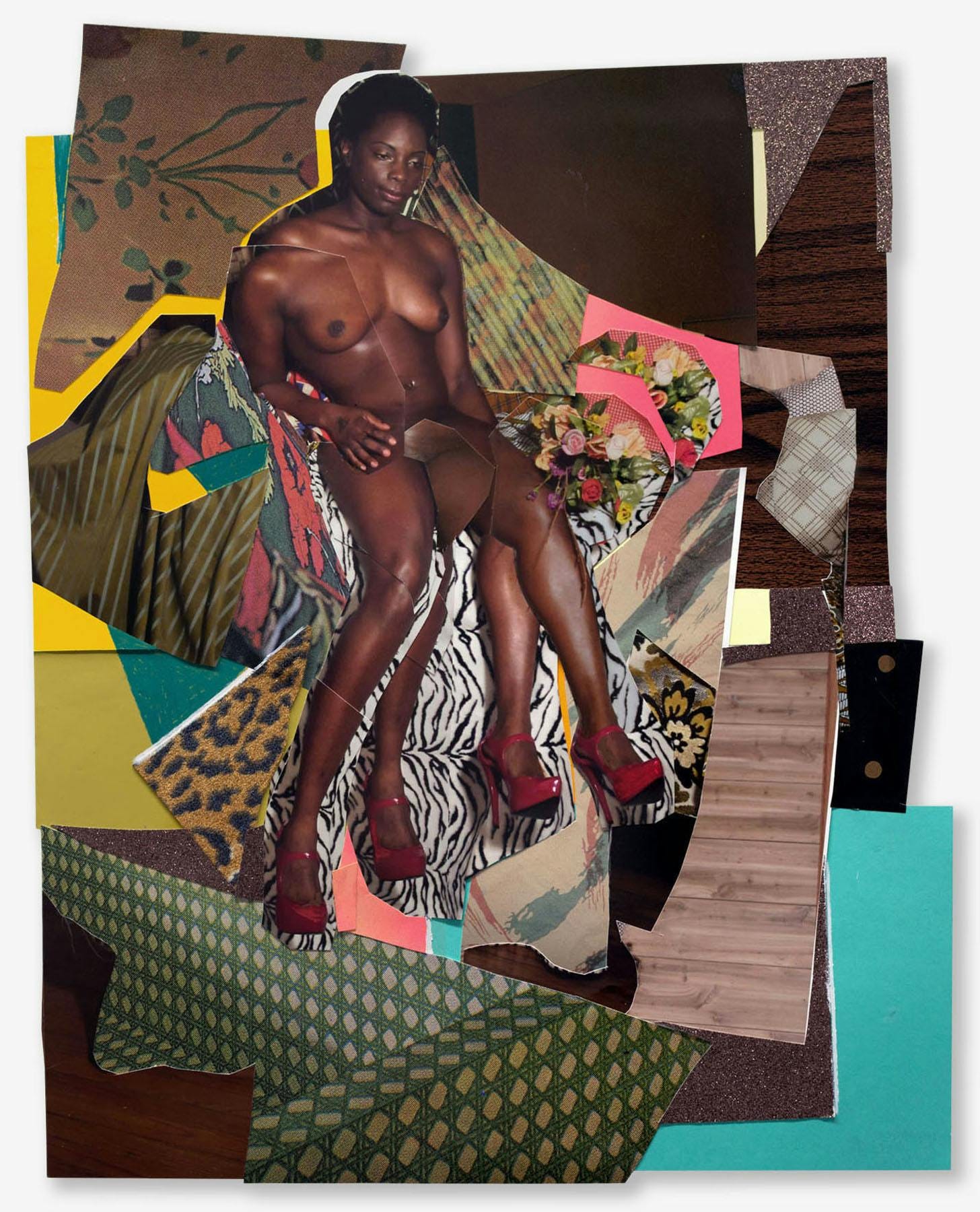
Mickalene's identity as a queer woman further layered her perspective. Navigating the intersections of race, gender, and sexuality informed her awareness of marginalization—and fueled her drive to create images where black women, and queer bodies more broadly, could be seen as powerful, complex, and undeniably beautiful.
Early Exposure to Art and Education
Growing up, Mickalene was surrounded by magazines like Ebony and Jet, which celebrated the glamour and power of black women, Thomas grew up with a rich visual vocabulary rooted in black beauty and representation. Cultural icons like Pam Grier also helped form her sense of bold, female empowerment. She was introduced to fine art as a child through after-school programs and frequent museum visits, encountering influential artists like Manet, Matisse, and members of the Hudson River School—many of whom she would later reference in her own work.
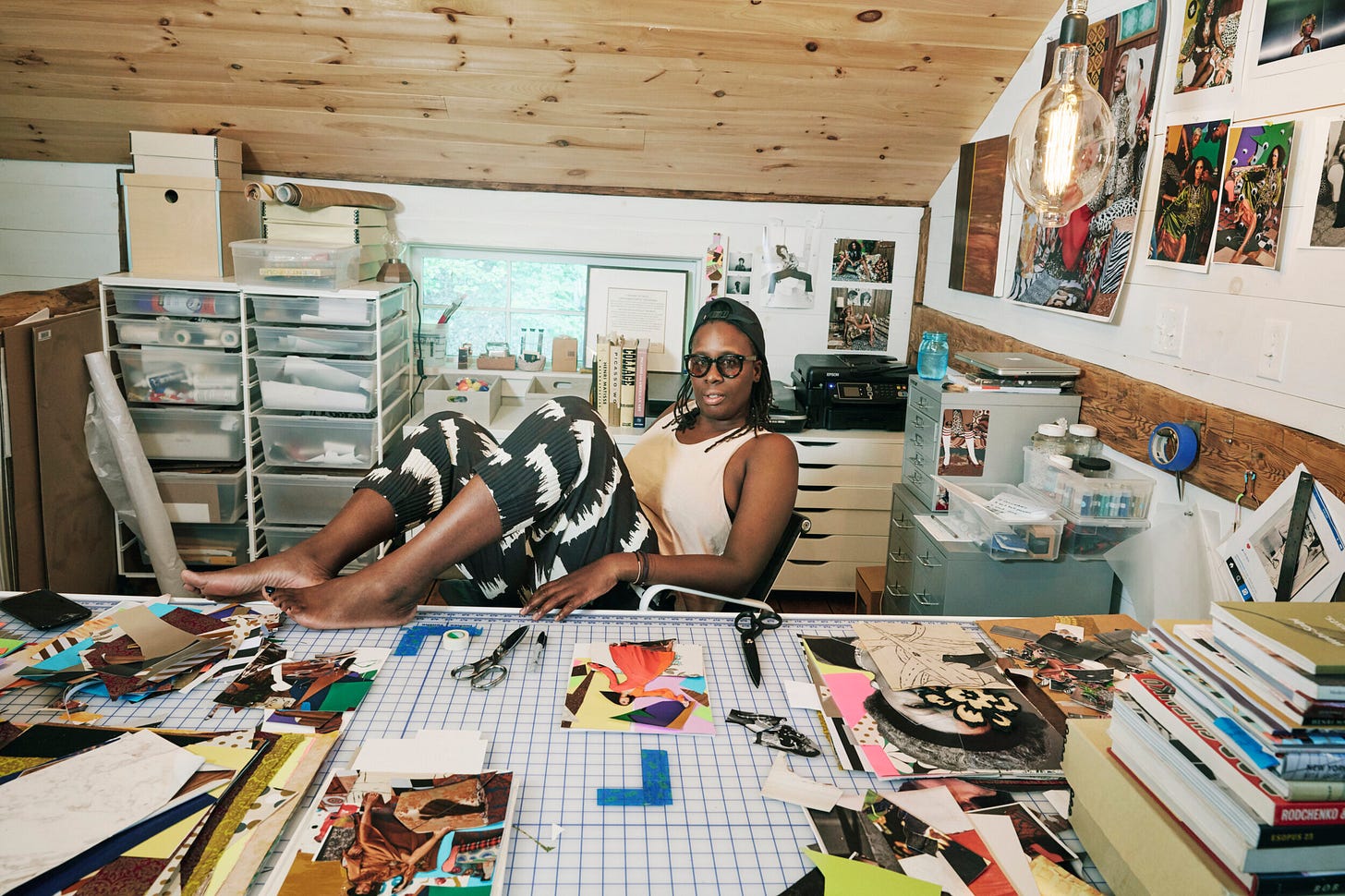
Initially, Thomas didn’t plan to pursue art professionally. After high school, she moved to Portland, Oregon, to study prelaw and theater arts at Portland State University. Immersed in a creative community of artists and musicians, she began drawing more seriously. The turning point came during a visit to the Portland Art Museum, where she encountered Carrie Mae Weems’s The Kitchen Table Series. Seeing Weems’s powerful depiction of Black womanhood in a museum setting was a revelation for Thomas—it was the first time she saw contemporary art that reflected her identity. That moment, as she later recounted, made her realize she was meant to be an artist.
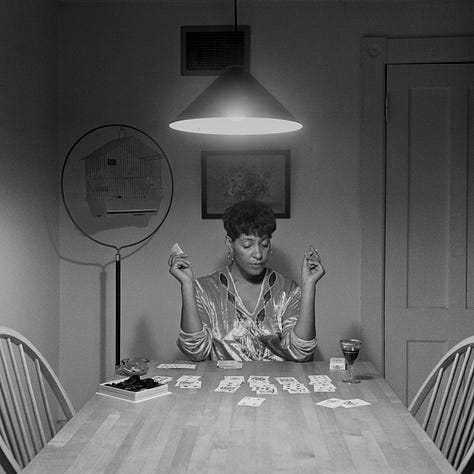
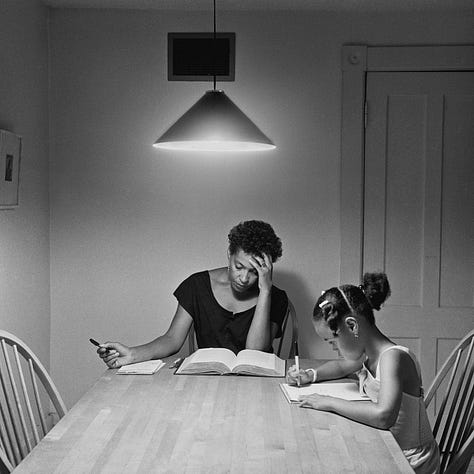
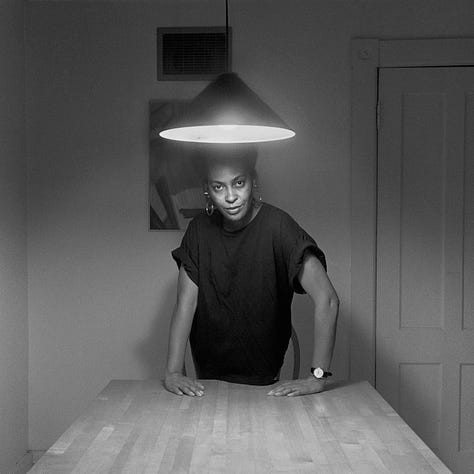
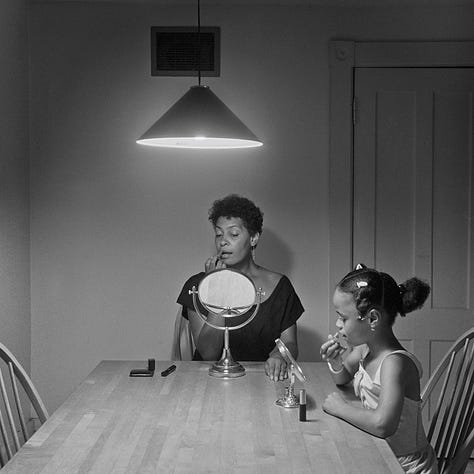
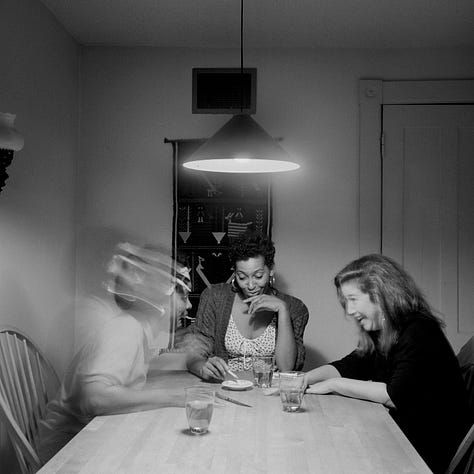
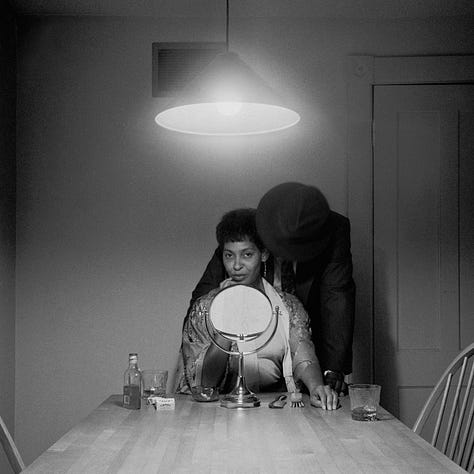
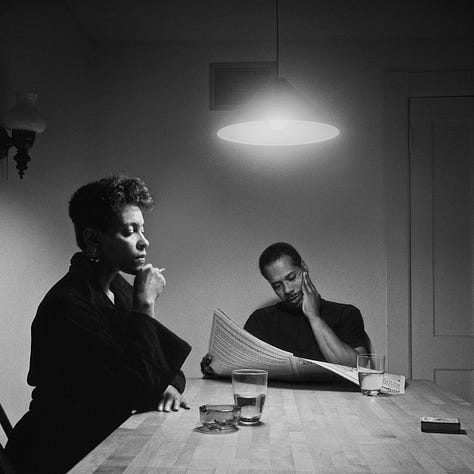

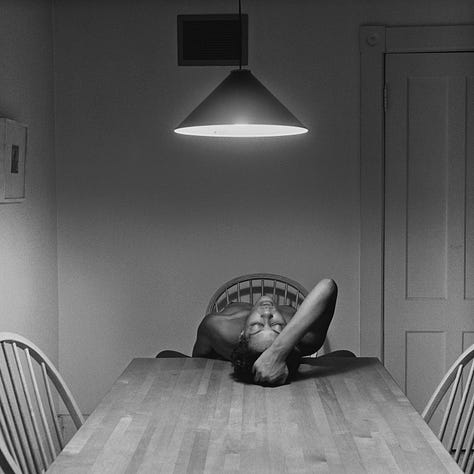
“It was the first time I saw contemporary art in a museum that reflected who I was. That was the moment that I knew I wanted to become an artist.”
— Mickalene Thomas in an interview with Whoopi Goldberg for Interview Magazine
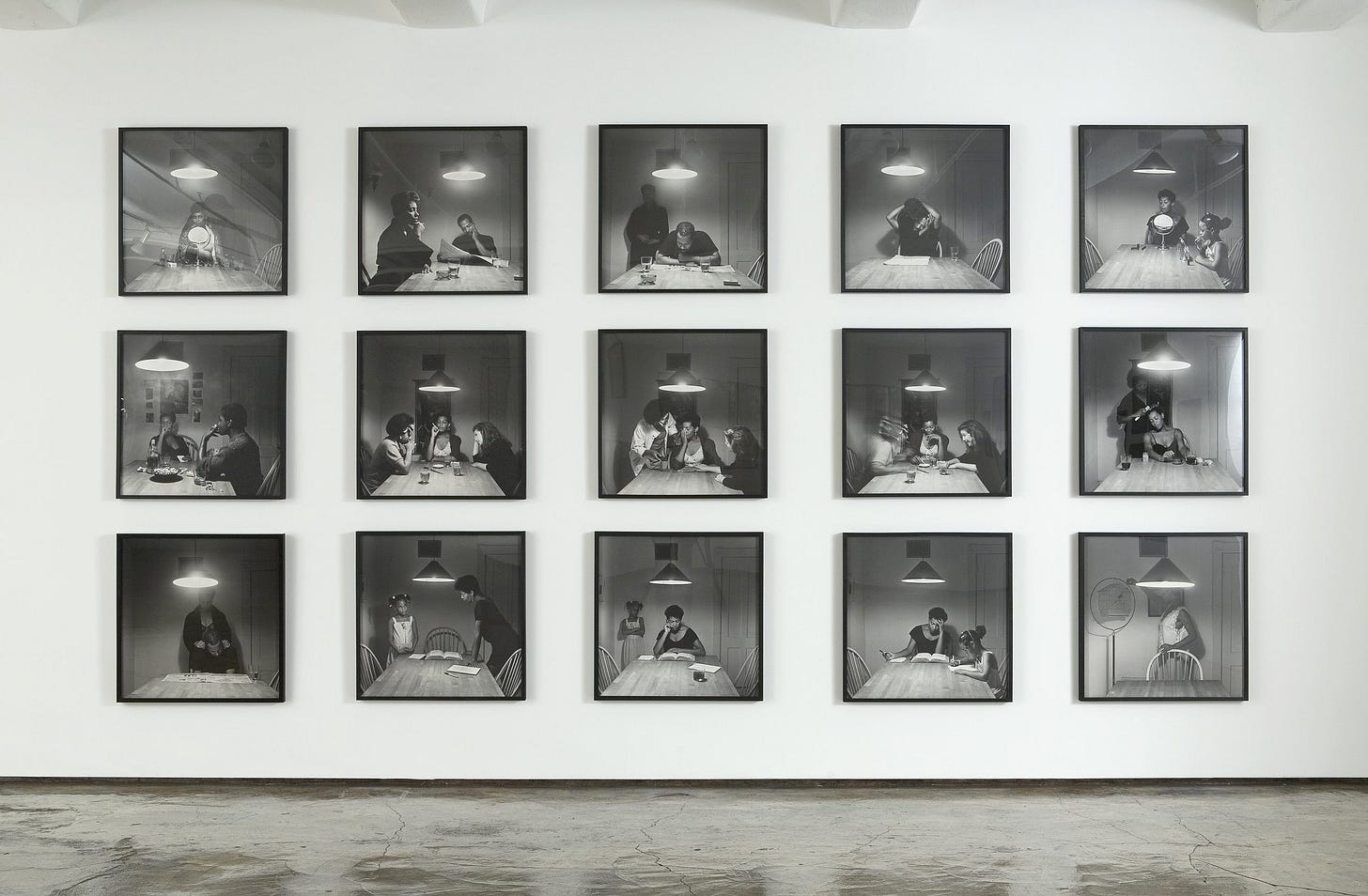
Thomas later transferred to the Pratt Institute in Brooklyn, where financial constraints led her to experiment with alternative materials like yarn, rhinestones, glitter, and sequins—elements that became hallmarks of her signature style. Photography also entered her practice during this time as she began photographing models to serve as the basis for her paintings. She graduated with a BFA in 2000 and went on to earn an MFA from Yale School of Art in 2002, further developing the unique mixed-media aesthetic that has since defined her career.
Mentors and exposure to feminist and critical race theory further empowered her to question and dismantle traditional hierarchies in art. Education was not just about technical skill—it was a political awakening that emboldened Thomas to redefine who and what could be considered art.
Artistic Influences and Style
Key Influences
Mickalene Thomas’s art is a dynamic conversation with art history. She draws inspiration from figures like Henri Matisse, Romare Bearden, and Gustave Courbet, repurposing their formal techniques while subverting their Eurocentric narratives. Thomas’s vibrant use of pattern, ornamentation, and layering creates a dialogue with Cubism and Modernism but through the lens of black, queer femininity.
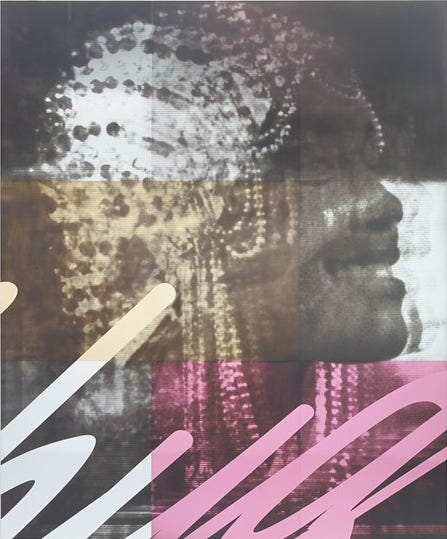
Photography, collage, and the aesthetics of 1970s black culture—from fashion magazines to home decor—also inform her style. Her works are known for their lush surfaces, combining rhinestones, acrylic, enamel, and fabric in dazzling tapestries of color and texture.
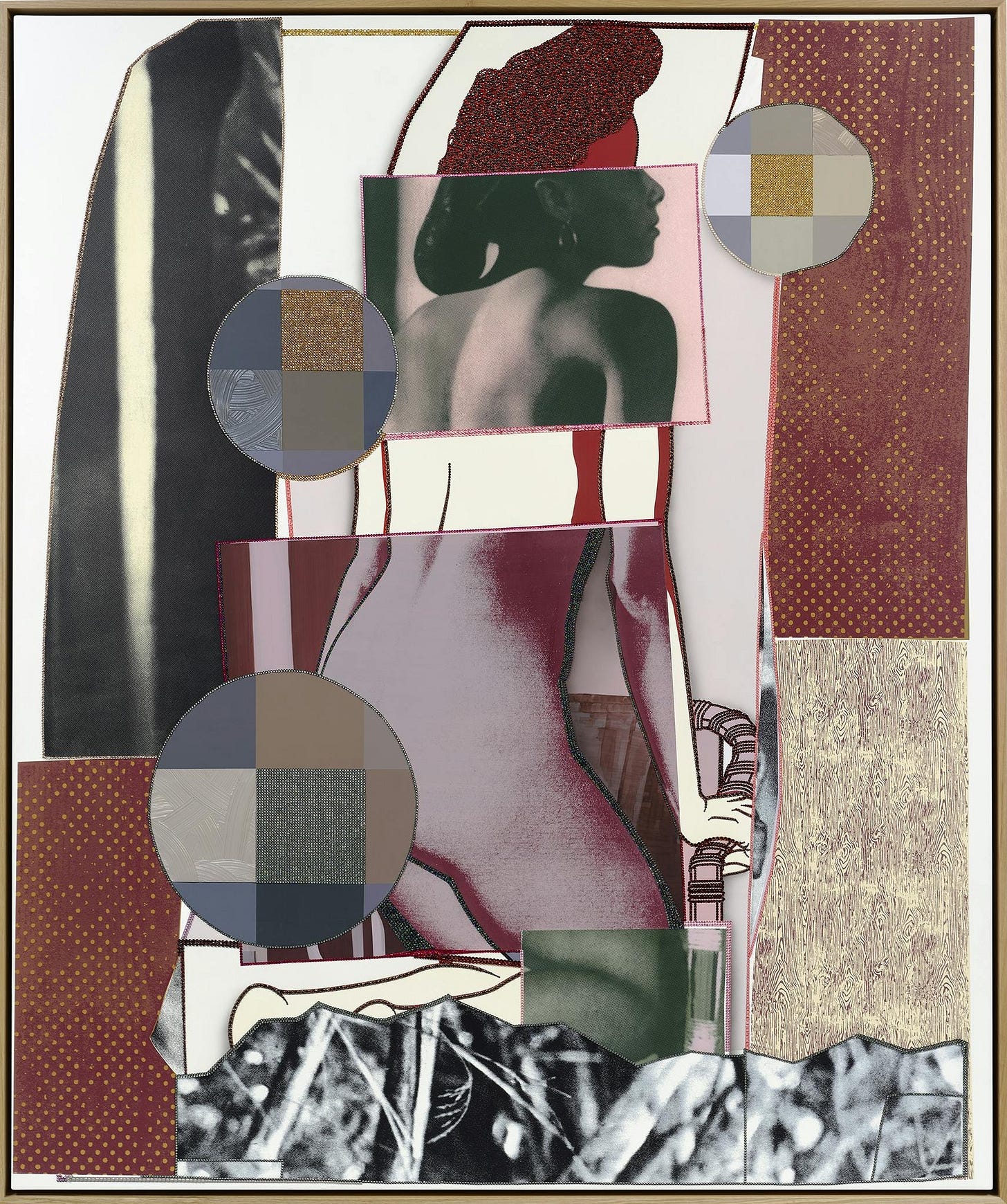
These elements both glamorize and celebrate her subjects while simultaneously critiquing the limited depictions of black bodies in mainstream art.
“A lot of my work begins with the ideation process, because what happens prior to even sitting with the blank canvas is part of bringing the artwork to fruition. Doing the research and experiencing the excitement around it entices and drives me and allows the aha moments. I go online and create Dropbox folders and start downloading images and collecting all these pictures. It starts with acting on those ideas through research. And also by reading, because maybe there’s literary support around that. Then I start to think, Do I want to just use the archival images, or do I want to create my own resources by doing a photo shoot or reaching out to people? I also see if maybe there’s a documentary related to my subject. And I make a list of things that I’m thinking about, which propels other ideas.
…
I’ll make a series of collages. Sometimes it’s with the same image. I’ll print out photographic images and start making this sort of body of work through collage by [changing] the composition, the color, and the texture. And while I’m working on those collages, I’m thinking of how I want to execute it in the painting. And then those collages become their own bodies of work.”
— Mickalene Thomas in an interview with Bryna Jean-Marie for Oprah Daily
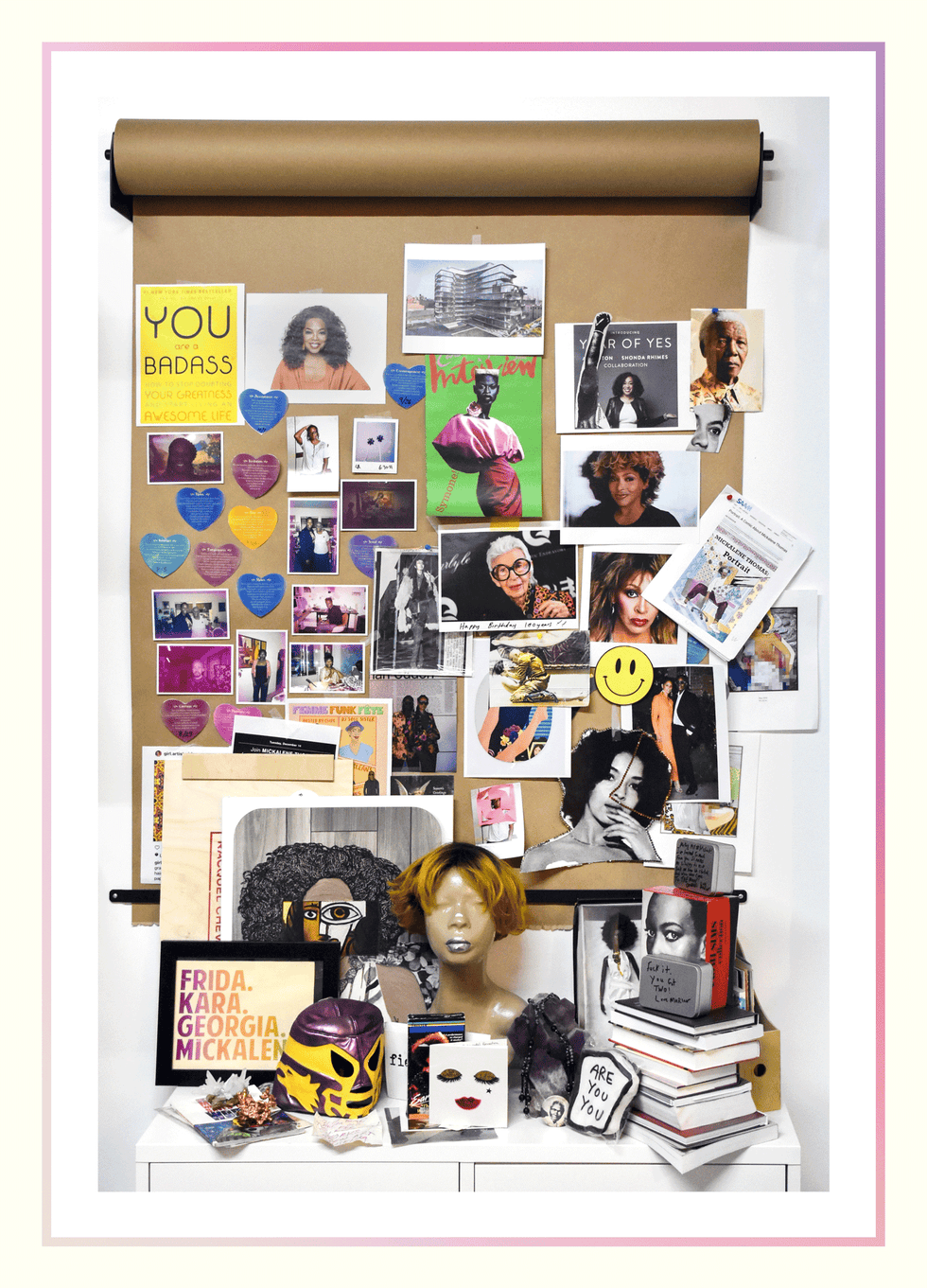
By reinterpreting iconic compositions with black women at the center, Thomas shifts the narrative. Her art doesn't just add black figures into traditional scenes—it redefines what those scenes can mean when seen through different eyes and experiences.
Art + Identity
Identity is the very soul of Thomas’s artistic practice. She positions black women—especially queer black women—as subjects worthy of complexity, beauty, and attention. Her portraits challenge simplistic or tokenistic representations, offering instead a multifaceted exploration of strength, sensuality, vulnerability, and pride.
“I perceive beauty in a myriad of ways, and I think it has to do with experience. It started for me at home, growing up, looking at my mother and my grandmother and how they saw themselves. They never allowed who they were or how they were perceived to be an obstacle. It was never age or color that prevented them from doing anything. So I see beauty as a perseverance and resilience in a person. It’s definitely something that exudes from the inside out. It’s how you’re a magnet and how you attract things in your life.”
— Mickalene Thomas in an interview with Whoopi Goldberg for Interview Magazine
Her personal experiences as a queer woman deeply influence how she constructs narratives around her subjects. Rather than merely photographing or painting them, she collaborates with her muses to craft empowering representations that resist objectification. Trust and mutual respect are critical components of her process, allowing her subjects to command their own narratives.
Her muses honor the women in her life—friends, lovers, family members—positioning them not merely as subjects of admiration but as co-creators of cultural meaning. In each project, Thomas reframes the idea of the muse as an active participant in shaping artistic vision.
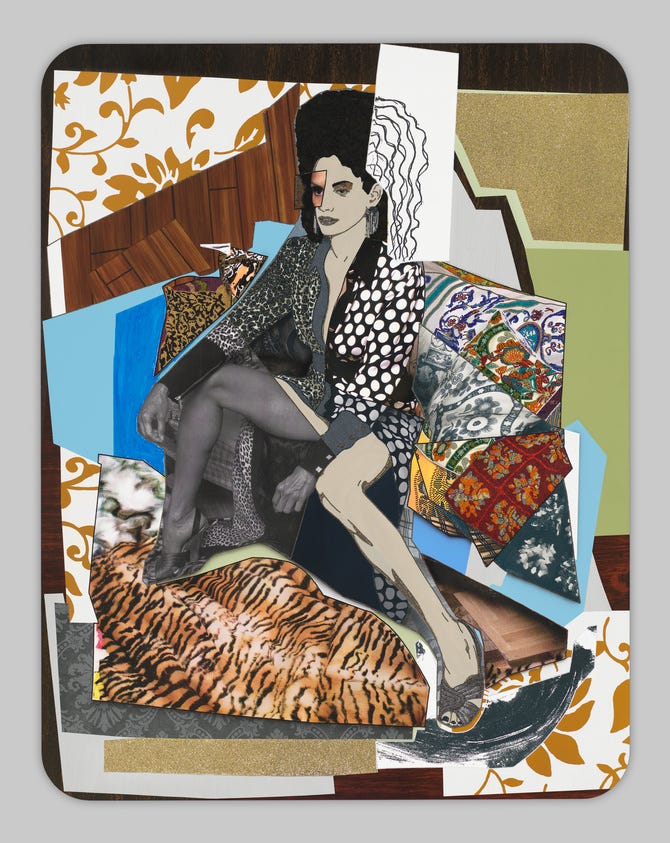
Beyond portraiture, Thomas’s installations recreate living spaces that echo the homes she knew growing up. These domestic interiors are layered with texture, memory, and cultural codes, turning personal spaces into declarations of black, queer existence and resistance.
Art + Activism
For Thomas, art is inherently political. By centering black, queer bodies, she challenges systems of exclusion and reclaims visual narratives. Her work calls attention to who gets to occupy spaces of beauty, power, and significance, effectively reshaping cultural memory.
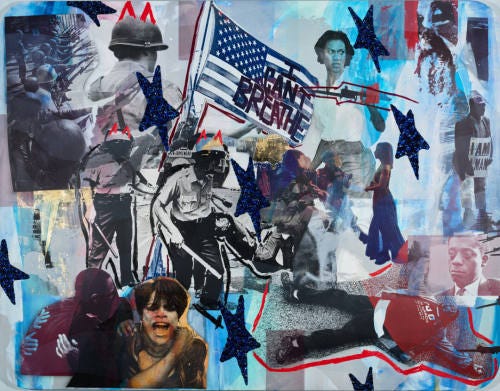
Thomas is an outspoken advocate for equity in the art world. She has launched initiatives like the "Art for Justice Fund," donating works to causes addressing mass incarceration and systemic racism. In addition, she mentors emerging artists, particularly women and LGBTQIS2S+ creatives, emphasizing community over competition.

Through exhibitions, installations, and activism, Mickalene reminds viewers that visibility itself can be an act of resistance. Her art pushes beyond representation to create new paradigms of belonging—where blackness, queerness, and femininity are not merely tolerated but celebrated.
Keep reading with a 7-day free trial
Subscribe to Pride Palette to keep reading this post and get 7 days of free access to the full post archives.






